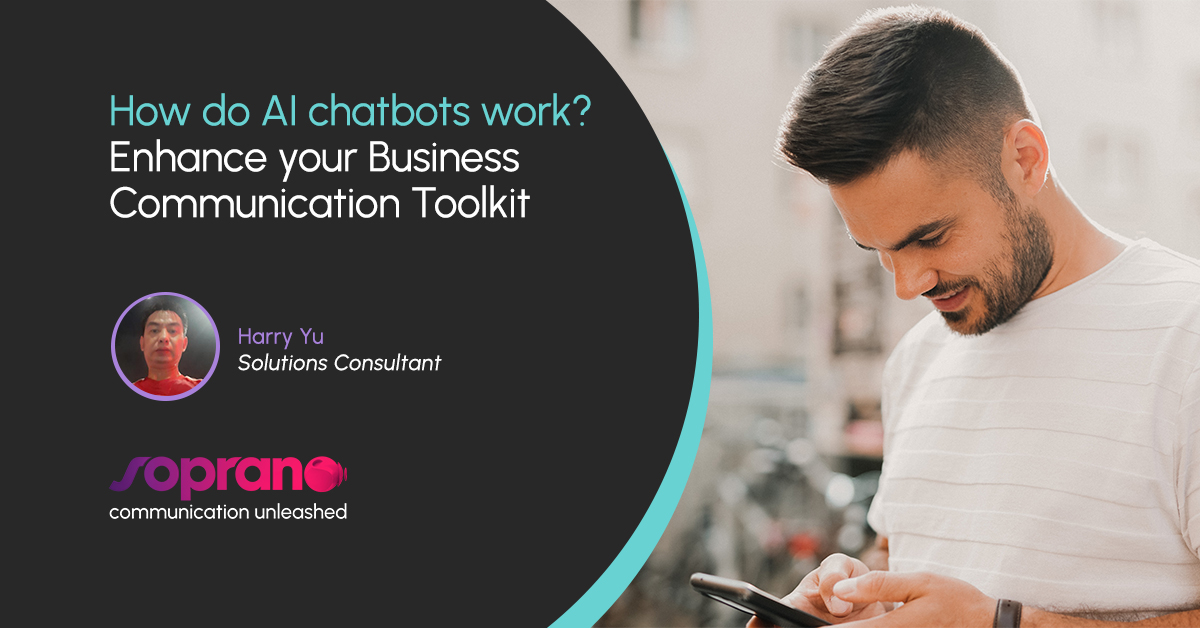How do AI chatbots work? Enhance your Business Communication Toolkit
Imagine a customer reaches out via your website with a product-related question and leaves happy, after getting answers to their questions. Imagine the same three or four questions being asked over and over by different customers and you have the ability to field those questions easily, repeatedly and consistently through your website.
Now, imagine all of that but with no human agent involved. Is that even possible, you may ask?
Introducing the AI chatbot, which is able to do all of the above with ease.
What are AI chatbots?
An AI chatbot is a piece of artificial intelligence. It is software that can simulate a user conversation with natural language that is done through messaging applications. This means the computer steps in (where a person used to) but does so in a sophisticated way by mimicking what a human conversation may sound like.
This makes the chatbot a powerful communication tool with great benefits for businesses.
Powered by the latest in AI technology, companies use chatbots on their websites to provide automated communication to their customers and visitors. The chatbot responds to customer comments, feedback or inquiries as these occur in real-time.
How would you know that you’ve interacted with a chatbot? An example might be when you visit a website researching more about a product or reading a blog article and a window pops up on the screen asking if you need any help. This is a scenario where you may encounter a chatbot.
How do AI chatbots work?
The use of chatbots increases automation which, in turn, means that companies can reduce the number of times humans are called to intervene in supporting customers. Think of them as virtual assistants.
What is great about the chatbot tool is that it is learning software. This means that, over time, it is able to automatically improve its responses. This is machine learning in action i.e. the use of historical data as input to predict new output values.
This unique aspect allows technology to step up and relieve human agents of the need to communicate with some customers as parts of their conversation could be completed by the chatbot entirely on its own.
The AI-powered chatbot simulates communication by implementing the latest AI technologies. The AI engine will query the knowledge bases of the company and provide the most accurate answers to questions from chatbot users.
An integral element of the interaction between chatbot and human is Natural Language Processing. A subfield of linguistics, computer science and artificial intelligence, Natural Language Processing involves the application of computational techniques to the analysis and synthesis of natural language. In layman’s terms, it seeks to fill the gap between human communication and computer understanding.
How AI chatbots are used
Companies incorporate AI chatbots into their marketing and communication strategy. They may be incorporated at many different stages within a customer journey.
For example, a chatbot may be tasked with lead generation which they do by starting conversations with standard openers and with questions.
The way in which you use a chatbot and the questions you get your chatbot to ask must be driven by your objectives.
Companies need to ask themselves these questions:
- What specific tasks do I want my chatbot to manage?
- In terms of outcomes, what will my chatbot assist me with?
- What does my chatbot need to integrate with?
Chatbots can offer common prompts and answers to upper-funnel questions. Let’s start with the common prompts.
The prompts themselves will depend on the activity they relate to. For example, if the company’s objective is lead generation, the chatbot will want to ask questions such as “What is your name?” and “What is an email address you can share?”
If the objective is to assist in booking appointments, the questions may be in the following order: “Would you like to schedule an appointment?” followed by a link to a calendar with available options to select from and also, an option to cancel an appointment.
If the objective of your chatbot is to assist in sales, questions may flow in this order: “Are you looking for a sports bag?” followed by “Do you want something chic or sporty looking?” and then, “What color would you like it in?” Then the options for that color may be displayed.
What are upper-funnel questions? A marketing term, this refers to strategies to build brand awareness. What the chatbot does here is less about selling something to the customer and far more about helping them, understanding what they need and what the chatbot can do to educate as well as address common questions.
Another area in which chatbots are particularly helpful lies in customer service. Human agents save time by having an AI chatbot open and start any customer-related conversation. The chatbot, through its questions, gains context on this issue raised, and passes this context on while gathering information to pass to a human agent in the event the chatbot is unable to resolve the issue.
Managing the risks associated with AI chatbots
As with many other initiatives, there is risk associated with reward. The risks, however, are limited as far as we know. Depending on the AI software powering the chatbot, you will need to ensure that the AI is learning all the appropriate patterns so that it is able to serve customers in the most appropriate way.
After all, you want customers to feel like they are being attended to and supported. If your chatbot is too rigid, the conversation may lack that personal touch. This will not reflect the voice of your brand well.
Chatbots may have limited responses, especially in the face of multi-part questions. If customers are left without a solution, they have to go through other steps to contact your support team.
This may lead to impatience and frustration. This is why a good approach is to consider an omnichannel customer experience strategy that run in parallel with and supplement your AI chatbot efforts.
Website forms, mobile apps, email and SMS are all examples of other communication channels that can come together, with the chatbot, to present an integrated approach. The key factor in your channel selection is how you can increase conversion rates effectively and provide an engaging customer experience.
Soprano leads the way in AI chatbots
A well-established and global communications-as-a-service (CPaaS) provider, Soprano includes AI chatbots as part of an end-to-end communications solution. As such, clients are able to bring AI chatbots into their overall communications strategy.
If you are considering incorporating chatbots in your communication strategy, rest assured that these best-in-class AI tools will ensure that your contact centers are fully equipped to care for customers at scale.


